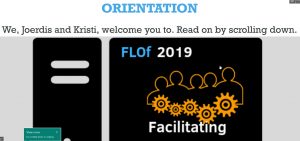How to get started in FLOf?
Joerdis Weilandt
Setting the scene
PURPOSE OF THE ORIENTATION TO FLOf2019: The facilitated FLOf2019 course started with a 3-pronged Orientation activity the participants needed to do in order to unlock the subsequent five modules in the course. The intention behind the Orientation was for the participants to get informed about the requirements for an engagement with the course, its facilitators and the other participants. In addition, it encouraged the participants to navigate the course resource pack and Moodle as the two major online environments that were being used to deliver the course.
Preceding step: Students read the Course Syllabus
Activity 1: Students sign a copy of Online Learning Conduct Form
Activity 2: Students communicate their professional teaching experience and their online teaching needs
Activity 3: Students add comments to and sign the Course Agreement
TECHNOLOGY: For the orientation, a range of different tools was used to deliver information, to encourage communication and to assess student needs. Please refer to the specific chapter in this resource for a detailed summary.
INSTRUCTIONS:
If you would like to explore the three Introduction activities click on this link.
Although originally intended as an instructor-paced linear online course, in which the participants would move through the course modules in chronological order, you now have full freedom to jump wherever your interest takes you. There is no need to follow a specific order to explore the individual topics.
TEACHING INTENTIONS:
Students need to learn to manoeuvre the unique challenges of online learning. Especially those students who have not taken an online course before are ill equipped in terms of applicable learning strategies that allow for better management and more effective communication via text. It is therefore recommended that online instructors build in orientation and success activities to provide opportunities for learners to not only comprehend the course requirements but to actively commit to planning as well as tracking their participation in the course.
Bowman, L. (2012, January 25). Orientation to Online Learning: Preparing Students for Initial and Ongoing Success Across the Curriculum | Online Learning Consortium, Inc. https://secure.onlinelearningconsortium.org/node/425296
Glazer, H. R., & Murphy, J. A. (2015). Optimizing success: A model for persistence in online education. American Journal of Distance Education, 29(2), 135–144.
Gumbo, M. T. (2016). Online learning experiences of students in the MEd in open and distance learning: A phenomenography of the dual university initiative [PhD Thesis].
Jones, K. R. (2013). DEVELOPING AND IMPLEMENTING A MANDATORY ONLINE STUDENT ORIENTATION. Online Learning, 17(1). https://doi.org/10.24059/olj.v17i1.312
Kelly, O. (2013). Orienting students to online learning: Going like a dream or still a nightmare? ASCILITE-Australian Society for Computers in Learning in Tertiary Education Annual Conference.
Lethbridge College. (n.d.). New Student Orientation for Online Learners. Retrieved January 28, 2020, from https://lethbridge.instructure.com/courses/14174
Liu, J. C., & Adams, A. (2017). Design of online student orientation with conceptual and procedural scaffolding. In Learning and Knowledge Analytics in Open Education (pp. 41–68). Springer.
Scheitler, J. A. (2015). Orientation programs for online learning in community colleges and the impact on student self-efficacy. Northeastern University
Taylor, J. M., Dunn, M., & Winn, S. K. (2015). Innovative orientation leads to improved success in online courses. Online Learning, 19(4), n4
Watts, J. (2019). Assessing an Online Student Orientation: Impacts on Retention, Satisfaction, and Student Learning. Technical Communication Quarterly, 28(3), 254–270.


